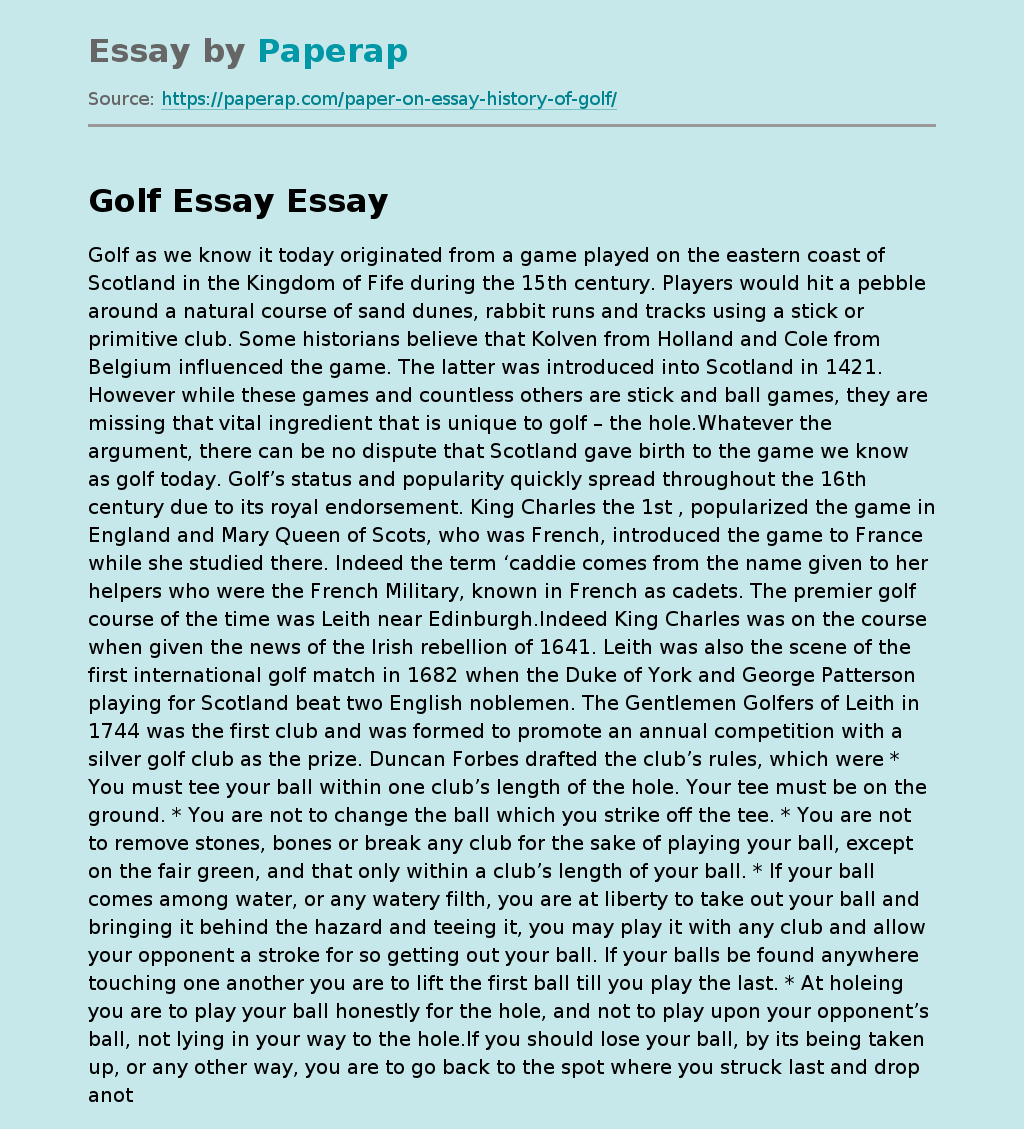Golf and Cole from Belgium Essay
Golf as we know it today originated from a game played on the eastern coast of Scotland in the Kingdom of Fife during the 15th century. Players would hit a pebble around a natural course of sand dunes, rabbit runs and tracks using a stick or primitive club. Some historians believe that Kolven from Holland and Cole from Belgium influenced the game. The latter was introduced into Scotland in 1421. However while these games and countless others are stick and ball games, they are missing that vital ingredient that is unique to golf – the hole.
Whatever the argument, there can be no dispute that Scotland gave birth to the game we know as golf today.
Golf’s status and popularity quickly spread throughout the 16th century due to its royal endorsement. King Charles the 1st , popularized the game in England and Mary Queen of Scots, who was French, introduced the game to France while she studied there. Indeed the term ‘caddie comes from the name given to her helpers who were the French Military, known in French as cadets.
The premier golf course of the time was Leith near Edinburgh.Indeed King Charles was on the course when given the news of the Irish rebellion of 1641. Leith was also the scene of the first international golf match in 1682 when the Duke of York and George Patterson playing for Scotland beat two English noblemen.
The Gentlemen Golfers of Leith in 1744 was the first club and was formed to promote an annual competition with a silver golf club as the prize.
Duncan Forbes drafted the club’s rules, which were You must tee your ball within one club’s length of the hole. Your tee must be on the ground. You are not to change the ball which you strike off the tee. You are not to remove stones, bones or break any club for the sake of playing your ball, except on the fair green, and that only within a club’s length of your ball. If your ball comes among water, or any watery filth, you are at liberty to take out your ball and bringing it behind the hazard and teeing it, you may play it with any club and allow your opponent a stroke for so getting out your ball. If your balls be found anywhere touching one another you are to lift the first ball till you play the last.
At holeing you are to play your ball honestly for the hole, and not to play upon your opponent’s ball, not lying in your way to the hole.If you should lose your ball, by its being taken up, or any other way, you are to go back to the spot where you struck last and drop another ball and allow your opponent a stroke for the misfortune. No man at holeing his ball is to be allowed to mark his way to the hole with his club or anything else. If a ball be stopped by any person, horse or dog, or anything else, the ball so stopped must be played where it lies.
If you draw your club in order to strike and proceed so far in the stroke as to be bringing down your club; if then your club shall break in any way, it is to be accounted a stroke. He who whose ball lies farthest from the hole is obliged to play first. Neither trench, ditch or dyke made for the preservation of the links, nor the Scholar’s Holes or the soldier’s lines shall be accounted a hazard but the ball is to be taken out, teed and played with any iron club.The first women’s golf club in the world was formed there in 1895. King William honored the club with the title ‘Royal & Ancient’ in 1834 and the new famous clubhouse was formed in 1854. The Royal and Ancient Golf
Club of St Andrews became the premier golf club because of its fine course, the publication of rules, its royal patronage and its promotion of the game as a proper sport. Of course, by this time golfers were using proper clubs and balls.Club heads were made from beech or the wood of fruit trees such as apple. Some club heads for were made from hand-forged iron. Shafts were usually ash or hazel. Balls were made from tightly compressed feathers wrapped in a stitched horse hide sphere. The sport was somewhat exclusive due to the expense of the handcrafted equipment. After 1826, perimmon and hickory were imported from the USA to make club heads and shafts respectively. Today these antiques are highly prized by collectors.
Golf and Cole from Belgium Essay. (2019, Dec 05). Retrieved from https://paperap.com/paper-on-essay-history-of-golf/

